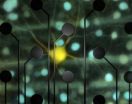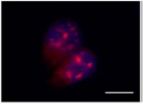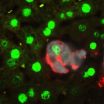(Press-News.org) The way we navigate from A to B is controlled by two brain regions which track the distance to our destination, according to new research funded by the Wellcome Trust and published in Current Biology.
The study found that at the beginning of a journey, one region of the brain calculates the straight-line to the destination ('the distance as a crow flies'), but during travel a different area of the brain computes the precise distance along the path to get there.
The findings pinpoint the precise brain regions used and in doing so change how scientists believed we use our brain to navigate. Previously, researchers had disagreed over whether the brain calculates a route or calculates the straight-line to a destination. By revealing that the brain does both this research indicates not only that both ideas were correct, but should also be integrated.
Dr Hugo Spiers and his team at UCL used film footage to recreate the busy streets of Soho in London (UK) inside an MRI scanner. Study participants were asked to navigate through the district, famous for its winding roads and complex junctions, whilst their brain activity was monitored. The researchers analysed brain activity during the different stages of the journey: setting course for the destination, keeping track of the destination while travelling, and decision making at street junctions.
The team found that activity in the entorhinal cortex, a region essential for navigation and memory, was sensitive to the straight-line distance to the destination when first working out how to get there. By contrast, during the rest of the journey, the posterior hippocampus, also famous for its role in navigation and memory, became active when keeping track of the path needed to reach the destination.
The results also reveal what happens in our brain when we use a Sat Nav or GPS to get to a destination. By recording brain activity when participants used Sat Nav-like instructions to reach their goal, the researchers found that neither of the brain regions tracked the distance to the destination and in general the brain was much less active.
Dr Spiers said: "Our team developed a new strategy for testing navigation and found that the way our brain directs our navigation is more complex than we imagined, calculating two types of distance in separate areas of the brain." He also commented on how the results might explain why London taxi drivers famously end up with an enlarged posterior hippocampus: "Our results indicate that it is the daily demand on processing paths in their posterior hippocampus that leads to the impressive expansion in their grey matter".
"These findings help us understand the mechanisms by which the hippocampus and entorhinal cortex guide navigation. The research is also a substantial step towards understanding how we use our brain in real world environments, of which we currently know very little."
Dr John Williams, head of clinical activities, neuroscience and mental health at the Wellcome Trust said: "These findings provide insight into the underlying biology of mental health conditions which affect our memory. The hippocampus and entorhinal cortex are among the first regions to be damaged in the dementia associated with Alzheimer's disease and these results provide some explanation as to why such patients struggle to find their way and become lost. Combining these findings with clinical work could enable medical benefits in the future."
INFORMATION:
Reference
Howard LR, Javadi AH, Yu Y, Mill RD, Morrison LC, Knight R, Loftus MM, Laura Staskute L and Spiers HJ. Hippocampus and entorhinal cortex encode the path and Euclidean distance to goals during navigation. Current Biology. June 2104
Contact
Clare Ryan
Senior Media Officer
The Wellcome Trust
T: +44 (0)20 7611 7262
M: +44 (0)7534 143 849
E: c.ryan@wellcome.ac.uk
Notes for editors
About the Wellcome Trust
The Wellcome Trust is a global charitable foundation dedicated to achieving extraordinary improvements in human and animal health. It supports the brightest minds in biomedical research and the medical humanities. The Trust's breadth of support includes public engagement, education and the application of research to improve health. It is independent of both political and commercial interests. http://www.wellcome.ac.uk
About UCL (University College London)
Founded in 1826, UCL was the first English university established after Oxford and Cambridge, the first to admit students regardless of race, class, religion or gender, and the first to provide systematic teaching of law, architecture and medicine. We are among the world's top universities, as reflected by performance in a range of international rankings and tables. UCL currently has almost 29,000 students from 150 countries and in the region of 10,000 employees. Our annual income is more than £900 million.
http://www.ucl.ac.uk | Follow us on Twitter @uclnews | Watch our YouTube channel YouTube.com/UCLTV
New research explains how we use the GPS inside our brain to navigate
2014-06-05
ELSE PRESS RELEASES FROM THIS DATE:
Our own treacherous immune genes can cause cancer after viral infection
2014-06-05
HPV (human papillomavirus) infection is widely known to induce cancer. Many of the mutations that cause this virally-induced cancer are caused by a family of genes that normally combats viral infections, finds new UCL (University College London) research.
This raises the possibility of developing drugs to regulate the activity of these genes to prevent HPV-associated cancers from developing and reduce the ability of existing cancers to evolve resistance to treatments.
The research, published in Cell Reports, shows for the first time that genes from the 'APOBEC' family, ...
Cellular traffic control system mapped for the first time
2014-06-05
Cells must transport nutrients and messenger cargos through its membrane and transport them within the cell at the correct time and place. This procedure is complex and is regulated with the help of specific genes. If disturbances in the transport mechanism arise, severe diseases, such as diabetes, cancer and diverse neurological pathologies, are the consequence. The discovery of the molecular principles of cellular transport was honored with the Nobel Prize of physiology and medicine in 2013. While knowing the intracellular roads and the functioning of the cars that use ...
Unmasking viral invaders
2014-06-05
If you have it, you probably don't know it. Cytomegalovirus, or CMV, is perhaps one of the biggest pathogens you've never heard of—big, both proportionately and epidemiologically. It contains approximately 200 genes, compared to HIV's paltry 18, and it's everywhere. You can catch it as a preschooler salivating over blocks, or as a teenager experiencing your first kiss. Once you have it, you have it for life.
Good news: If you're healthy, it's harmless. Your T cells keep it in check, and you'll be none the wiser.
Bad news: If you have any medical condition that dampens ...
Making artificial vision look more natural
2014-06-05
In laboratory tests, researchers have used electrical stimulation of retinal cells to produce the same patterns of activity that occur when the retina sees a moving object. Although more work remains, this is a step toward restoring natural, high-fidelity vision to blind people, the researchers say. The work was funded in part by the National Institutes of Health.
Just 20 years ago, bionic vision was more a science fiction cliché than a realistic medical goal. But in the past few years, the first artificial vision technology has come on the market in the United States ...
Discovered a new way to control genetic material altered in cancer
2014-06-05
When we talk about genetic material, we are usually referring to the DNA (deoxyribonucleic acid) that we inherit from our parents. This DNA is the factory where is built a similar molecule called RNA (ribonucleic acid) which produces our proteins, such as hemoglobin or insulin , allowing the lives of our cells. But there is a special group called non-coding RNA that has a more enigmatic function.
The best known is microRNAs, tiny molecules that are responsible for turning on or off our genome like an electrical current switch. Today, an article published in the prestigious ...
A new model of liver regeneration
2014-06-05
Harvard Stem Cell Institute scientists at Boston Children's Hospital have new evidence in mice that it may be possible to repair a chronically diseased liver by forcing mature liver cells to revert back to a stem cell-like state.
The researchers, led by Fernando Camargo, PhD, happened upon this discovery while investigating whether a biochemical cascade called Hippo, which controls how big the liver grows, also affects cell fate. The unexpected answer, published in the journal Cell, is that switching off the Hippo-signaling pathway in mature liver cells generates very ...
Vanderbilt scientists discover that chemical element bromine is essential to human life
2014-06-05
Twenty-seven chemical elements are considered to be essential for human life.
Now there is a 28th – bromine.
In a paper published Thursday by the journal Cell, Vanderbilt University researchers establish for the first time that bromine, among the 92 naturally-occurring chemical elements in the universe, is the 28th element essential for tissue development in all animals, from primitive sea creatures to humans.
"Without bromine, there are no animals. That's the discovery," said Billy Hudson, Ph.D., the paper's senior author and Elliott V. Newman Professor of Medicine.
The ...
Flowers' polarization patterns help bees find food
2014-06-05
Like many other insect pollinators, bees find their way around by using a polarization sensitive area in their eyes to 'see' skylight polarization patterns. However, while other insects are known to use such sensitivity to identify appropriate habitats, locate suitable sites to lay their eggs and find food, a non-navigation function for polarization vision has never been identified in bees – until now.
Professor Julian Partridge, from Bristol's School of Biological Sciences and the School of Animal Biology at the University of Western Australia, with his Bristol-based ...
Stem cells hold keys to body's plan
2014-06-05
Case Western Reserve researchers have discovered landmarks within pluripotent stem cells that guide how they develop to serve different purposes within the body. This breakthrough offers promise that scientists eventually will be able to direct stem cells in ways that prevent disease or repair damage from injury or illness. The study and its results appear in the June 5 edition of the journal Cell Stem Cell.
Pluripotent stem cells are so named because they can evolve into any of the cell types that exist within the body. Their immense potential captured the attention ...
Couples sleep in sync when the wife is satisfied with their marriage
2014-06-05
DARIEN, IL – A new study suggests that couples are more likely to sleep in sync when the wife is more satisfied with their marriage.
Results show that overall synchrony in sleep-wake schedules among couples was high, as those who slept in the same bed were awake or asleep at the same time about 75 percent of the time. When the wife reported higher marital satisfaction, the percent of time the couple was awake or asleep at the same time was greater.
"Most of what is known about sleep comes from studying it at the individual level; however, for most adults, sleep is a ...


